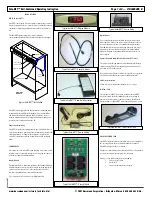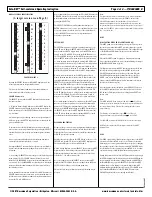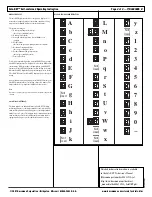
Once the desired setting is displayed, press the SELECT button on the
Safe-NET display module to store the new value to NV memory. The
display will revert to cycling between PSEN and the new value.
Note:
Factory default is NO to disable password protection for CLOCK and
DSET.
CNTN
The CNTN parameter sets the network address of the Safe-NET
control module to which Safe-NET display modules, or the master
network are connected.
This setting has no effect when the Safe-NET
system:
is applied as a temperature-monitoring device only; or,
does not require the Safe-NET control module; or,
is in a non-networked installation.
DSPN
The DSPN parameter sets the network address of the Safe-NET
display module. When the Safe-NET system applied does not require
the Safe-NET control module or is in a non-networked installation,
this setting has no effect.
NSEN
The NSEN parameter displays the number of temperature sensors
attached to the Safe-NET display module. The Safe-NET display
module scans the sensor network during each reset cycle to locate and
identify the attached sensors. Subsequent to a reset action, the number
of sensors detected is displayed here. The number of sensors is stored
in NV memory and is continuously compared to the number of
responding sensors. In this way failed or additional sensors are
detected.
Setting / viewing this parameter is done in the SETUP menu. After
navigating to the NSEN sub menu item, the display will cycle between
NSEN and the current number of sensors stored in NV memory.
LGHT
This setting assigns one of four possible outputs for control of case
lighting.
The Safe-NET system has an optional Relay Board component that
when attached, allows the Safe-NET display board to control up to
four outputs. The controlled outputs are assigned using the SETUP
MENU. The possible controlled output devices are:
1) Compressor (CMP)
2) Evaporator Fans (FANS)
3) Defrost Heaters (DHTR)
4) Anti-Sweat Heater (ANTI)
The Safe-NET system, by design, supports four control outputs. Since
not all possible controlled items are valid in any given configuration,
the Light control output is assigned to an unused output.
Setting this parameter is done in the SETUP menu. After navigating
to the LGHT sub menu item, the display will cycle between LGHT and
the current setting. While the current value is being displayed, press
the SELECT button on the Safe-NET display module to allow editing
of the value. When the Safe-NET display module begins flashing the
value, use the UP or DOWN arrow keys on the Hand-Held device or
the UP /DOWN buttons on the Safe-NET display module to increment
or decrement the value to the desired output.
DEGR
The DEGR parameter determines the units in which the Safe-NET
display module presents temperature information. The Safe-NET
display module is capable of displaying either degrees Fahrenheit or
degrees Celsius.
DUTY
The Safe-NET system has an optional Relay Board component that
when attached, allows the Safe-NET display board to control up to
four outputs. The possible controlled output devices are:
5) Compressor (CMP)
6) Evaporator Fans (FANS)
7) Defrost Heaters (DHTR)
8) Anti-Sweat Heater (ANTI)
The DUTY parameter determines the percentage of
ON
time for
control of Anti-Sweat heaters if installed and controlled by the
Safe-NET display module. The control period is 100 seconds.
A range of 0 to 100 is possible, with 0 =
OFF CONTINUOUSLY
to
100 =
CONTINUOUSLY ON
. Adjusting this parameter can improve energy
consumption. However, a setting of sufficient
ON
time is required to
prevent condensation from appearing on the fixture frame.
DIFF
The Safe-NET system is capable of controlling temperature inside the
refrigerated space of a refrigerated merchandiser. The Safe-NET system
can achieve this control in the various ways discussed earlier. When
ON/OFF control is selected, the control methodology makes use of a
set point and a control band known as a differential (DIFF). For
example: with a DIFF setting of 10, and DSET set point of 10 deg F,
the ON/OFF control method will attempt to maintain the 10
º
by
cycling the control device ON at temperatures above 10
º
and OFF
at 0
º
. This temperature control is superceded by a fixed minimum ON
time of 3 minutes. Hence lower DIFF settings will result in tighter
temperature control but more frequent control device (compressor,
valve) cycling. Conversely, higher DIFF settings will reduce control
device cycling at the expense of product integrity. Typically, this
setting is at user discretion.
FSET
The Safe-NET system is capable of controlling defrost activity and
scheduling. When the Safe-NET system is configured to control
evaporator fans during defrost, this setting provides a temperature set
point to resume evaporator fan operation after defrost cycle termina-
tion. This provides a means to delay activation of the evaporator fans
until the specified coil temperature is reached. This setting works in
conjunction with the FCTL menu option in the DEFROST MENU.
If FCTL (Fan Control) is disabled, this setting has no effect.
CTRL
The Safe-NET system is capable of controlling temperature inside the
refrigerated space of a refrigerated merchandiser. The Safe-NET system
can achieve this control in the various ways discussed earlier.
This parameter selects the temperature input to use in controlling the
temperature of the refrigerated space. Alarms and control set points
are applied to this temperature input source. Available sources are:
PrAv
•
Product Simulator Average
dSAv
•
Discharge Air Average
rtAv
•
Return Air Average
tnLo
•
Coil Temperature
PD-L
The PD-L parameter sets the alarm delay in minutes for the product
temperature simulator temperature. In the event that the sensed
temperature of the product simulator exceeds the pre-set high
temperature alarm setting for the product simulator temperature
for a period equal to or greater than the PD-L setting, the alarm is
signaled. This is true for low temperature alarms as well. There is only
one time delay associated with all product simulator temperature
alarms.
PRHI
The PRHI parameter sets the high temperature alarm set point for the
product simulator temperature. This set point and associated alarm is
valid for the Safe-NET system when applied as a Monitoring or
Control system. The configurable range of the HIGH alarm is
(control set point) +16 ºF.
Note:
A product simulator temperature sensor must be installed in order to
enable associated alarm functions.
PRLO
The PRLO parameter sets the low temperature alarm set point for the
product simulator temperature. This set point and associated alarm is
valid for the Safe-NET system when applied as a Monitoring or
Control system. The configurable range of the LOW alarm is (control
set point)
–
16 ºF.
Note:
A product simulator temperature sensor must be installed in order to
enable associated alarm functions.
ADLY
The ADLY parameter sets the alarm delay in minutes for the discharge
air temperature. In the event that the sensed temperature of the
product simulator exceeds the pre-set high temperature alarm setting
for the discharge air temperature sensor for a period equal to or
greater than the ADLY setting, the alarm is signaled. This is true for
low temperature alarms as well. There is only one time delay associated
with all discharge air temperature alarms.
Note:
One or more Discharge Air temperature sensors must be installed in order
to enable associated alarm functions.
HIGH
The HIGH parameter sets the high temperature alarm set point for the
discharge air temperature sensor(s). This set point and associated alarm
is valid for the Safe-NET system when applied as a Monitoring or
Control system. The configurable range of the HIGH alarm (control
set point) is +16 ºF.
LOW
The LOW parameter sets the low temperature alarm set point for the
discharge air sensor(s) temperature. This set point and associated alarm
is valid for the Safe-NET system when applied as a Monitoring or
Control system. The configurable range of the LOW alarm (control set
point) is
–
16 ºF.
Safe-NET™ Self-contained Operating Instruction
Page
5 of 8 — P/N 0485005_B
www.hussmann.com/cstore/c_techinfo.htm
© 2007 Hussmann Corporation • Bridgeton, Missouri 63044-2483 U.S.A.
20 June 2007


























